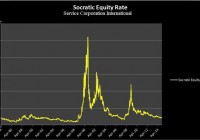Switzerland’s Monetary Policy Change – GLD Rallies
The Swiss National Bank’s decision to end its policy to peg the Swiss franc to the euro stirred up the financial markets. The decision seems to have also pulled up the price of GLD. How SNB’s decisions relates to the recent rally of GLD. The big news from the Swiss National Bank to stop pegging its currency to the euro has shocked the foreign exchange markets. Some analysts have also linked this move to the recent recovery of gold, including the SPDR Gold Trust ETF (NYSEARCA: GLD ). This relation, however, isn’t straightforward – let’s examine the recent rally of GLD . After over three years, the SNB announced an end to its policy to peg the currency at a minimum exchange rate of 1.20 euro to the Swiss franc. The ongoing devaluation of the euro has, according to the bank, triggered it to make this move. As Thomas Jordan, chairman of the SNB, stated : “Recently, divergences between the monetary policies of the major currency areas have increased significantly – a trend that is likely to become even more pronounced. The euro has depreciated substantially against the US dollar and this, in turn, has caused the Swiss franc to weaken against the US dollar. In these circumstances, the SNB has concluded that enforcing and maintaining the minimum exchange rate for the Swiss franc against the euro is no longer justified.” This decision has stirred up the financial markets – mainly devaluing the euro against leading currencies, including the U.S. dollar. Normally, an appreciation of the U.S. dollar would tend to coincide with a decline in the price of GLD. But the price of GLD kept going up. The SNB’s recent move actually raises the uncertainty in the financial markets, which plays in favor of gold investments such as GLD. Paul Krugman suggested that the implication of the recent regime change in Switzerland is that the markets will become more skeptical about other central banks, speculating whether these banks will follow through on their dovish policies. I think this is a bit of stretch, but some traders will make this connection – albeit one central bank’s policy change won’t necessarily impact the reliability of other banks. The latest news from SNB suggests the ECB’s next policy change could surprise the markets with a bigger than currently expected QE program. When it comes to GLD, however, the main issues relate to the changes in the U.S. dollar, the uncertainty in the markets and long-term treasuries yields. In the past week, the U.S. dollar devalued against the Swiss franc, which is now likely to keep recovering. U.S. long-term treasuries’ yields kept falling down, which tend to have a negative relation with the price of GLD. An economic slowdown does play in favor of GLD, because it tends to cut down U.S. treasuries’ yields. Moreover, the World Bank recently released its updated economic outlook for the next few years. The bank projects the global economy will grow by 3%, and not 3.4% as it previously estimated. It also revised down its outlook for China, EU and Japan. Albeit the U.S. GDP is expected to actually grow faster than previously estimated, the fear factor of global economic slowdown is keeping GLD up at least in the short term. This is another indication why the demand for gold on paper leads the way for physical demand for gold; if it were the other way around, an expected lower growth rate in China’s economy – the leading importer of gold – would have resulted in a drop in the price of gold. In any case, it seems that the physical demand for gold in the short term hasn’t picked up: The Gold Forward Offered Rate, or GOFO, has risen in recent weeks, after they were negative during part of December of 2014 (and several other times during last year). A rise in GOFO rates is another indication for a fall in the short-term physical demand for gold. The next big news item will be the upcoming ECB monetary policy meeting next week. This time, all eyes will be towards ECB president Draghi to see if he states the amount of the ECB’s QE program. Current market expectations are around 500-700 billion euros, albeit some have also suggested this figure could, in theory, even reach 2 trillion euros. So any number higher than this could drive further down the euro, which could push more investors towards precious metals, including GLD. Again, the appreciation of the U.S. dollar isn’t helping GLD, but a fear of ECB pumping cash into EU’s banks to buy sovereign debt could drive higher the demand for the yellow metal. The Swiss National Bank’s move shook up the foreign exchange market and apparently also, in the process, pulled up GLD. The next ECB monetary policy meeting could also be the next big event to stir up the foreign exchange markets and GLD – in times of uncertainty, GLD strives. (For more please see: ” On Demand for Gold and GOFO rates “)
